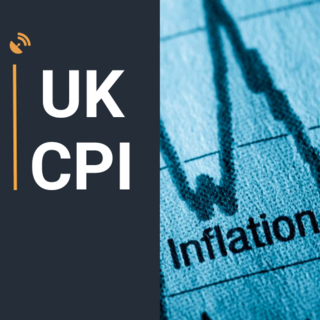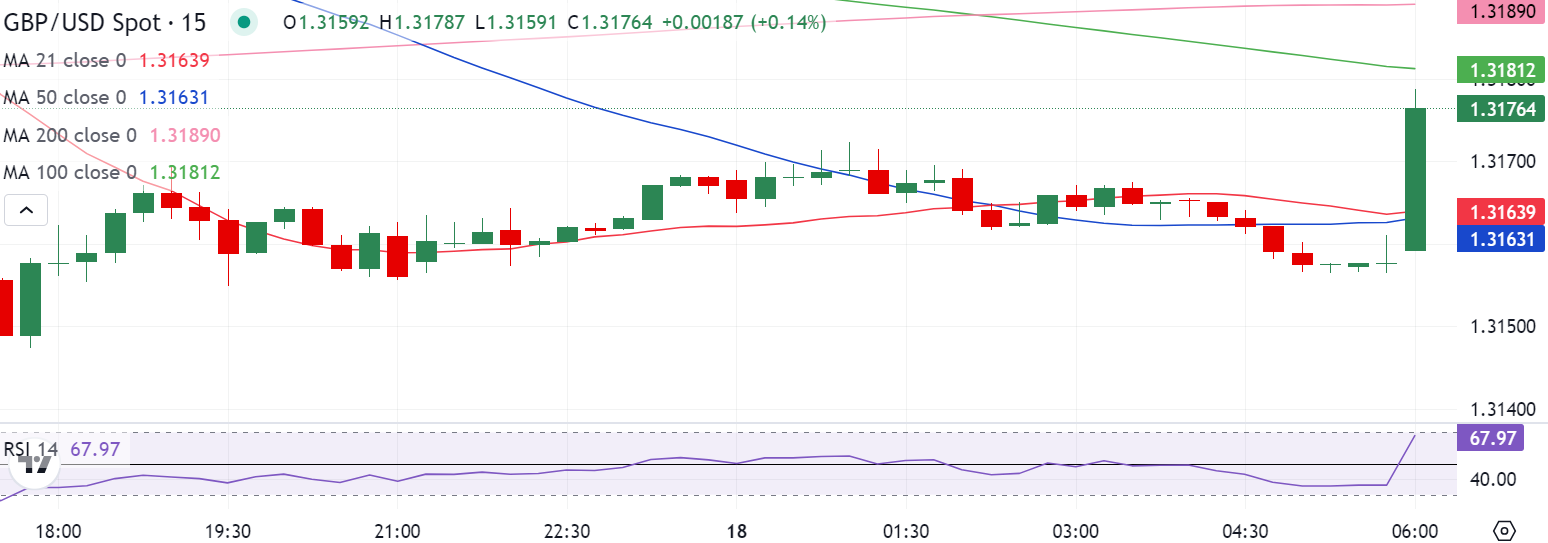UK CPI inflation stays unchanged at 2.2% YoY in August
|
- United Kingdom's annual CPI rose 2.2% in August, as expected.
- British inflation jumped to 0.3% MoM in August vs. 0.3% forecast.
- GBP/USD rises toward 1.3200 after UK CPI inflation data.
The United Kingdom (UK) Consumer Price Index (CPI) rose 2.2% over the year in August, following the July growth of 2.2%, data released by the Office for National Statistics (ONS) showed on Wednesday.
Data matched the expected 2.2% increase, staying above the Bank of England’s (BoE) 2.0% target.
Core CPI (excluding volatile food and energy items) edged higher by 3.6% YoY in August, as against a 3.3% advance reported in July while above the market forecast of 3.5%.
The UK August Services CPI inflation climbed to 5.6% YoY in August versus July’s 5.2%, well above the 5.0% level.
Meanwhile, the UK Consumer Price Index rebounded by 0.3% MoM in August after dropping 0.2% in July. The market consensus was for a 0.3% growth.
GBP/USD reaction to the UK CPI inflation data
The UK CPI data puts a fresh bid under the Pound Sterling, as the GBP/USD pair rises back toward 1.3200. The pair is trading 0.14% higher on the day near 1.3175, as of writing.
GBP/USD: 15-minutes chart
British Pound PRICE Today
The table below shows the percentage change of British Pound (GBP) against listed major currencies today. British Pound was the strongest against the US Dollar.
| USD | EUR | GBP | JPY | CAD | AUD | NZD | CHF | |
|---|---|---|---|---|---|---|---|---|
| USD | -0.06% | -0.10% | -0.61% | -0.08% | -0.17% | -0.31% | -0.24% | |
| EUR | 0.06% | -0.05% | -0.55% | -0.02% | -0.10% | -0.27% | -0.18% | |
| GBP | 0.10% | 0.05% | -0.47% | 0.02% | -0.05% | -0.23% | -0.11% | |
| JPY | 0.61% | 0.55% | 0.47% | 0.51% | 0.43% | 0.29% | 0.38% | |
| CAD | 0.08% | 0.02% | -0.02% | -0.51% | -0.08% | -0.27% | -0.13% | |
| AUD | 0.17% | 0.10% | 0.05% | -0.43% | 0.08% | -0.14% | -0.06% | |
| NZD | 0.31% | 0.27% | 0.23% | -0.29% | 0.27% | 0.14% | 0.09% | |
| CHF | 0.24% | 0.18% | 0.11% | -0.38% | 0.13% | 0.06% | -0.09% |
The heat map shows percentage changes of major currencies against each other. The base currency is picked from the left column, while the quote currency is picked from the top row. For example, if you pick the British Pound from the left column and move along the horizontal line to the US Dollar, the percentage change displayed in the box will represent GBP (base)/USD (quote).
This section below was published at 02:15 GMT as a preview of the UK Consumer Price Index (CPI) inflation data.
- The United Kingdom’s CPI is foreseen to grow at stable pace of 2.2% in the year to August.
- The Bank of England will announce its monetary policy decision on Thursday.
- The Pound Sterling is technically bullish and could surpass the 1.3300 mark.
The United Kingdom (UK) Office for National Statistics (ONS) will release August Consumer Price Index (CPI) figures on Wednesday. Inflation, as measured by the CPI, is one of the main factors on which the Bank of England (BoE) bases its monetary policy decision, meaning the data is considered a major mover of the Pound Sterling (GBP).
The BoE met in August and decided to trim the benchmark interest rate by 25 basis points (bps) to 5%, a decision supported by a slim majority of 5 out of the 9 voting members of the Monetary Policy Committee (MPC). The widely anticipated announcement had a negative impact on the GBP, which entered a selling spiral against the US Dollar, resulting in the GBP/USD pair bottoming at 1.2664 a couple of days after the event.
What to expect from the next UK inflation report?
The UK CPI is expected to have risen at an annual pace of 2.2% in August, matching the July print. The core annual reading is foreseen at 3.5%, higher than the previous 3.3%. Finally, the monthly index is expected to grow by 0.3% after falling by 0.2% in July.
It is worth adding that the BoE will announce its monetary policy on Thursday and that inflation levels could affect policymakers' decision. Ahead of the announcement, financial markets anticipate officials will keep rates on hold before adopting a more aggressive stance from November on. The central bank anticipated that inflation could reach 2.75% in the upcoming months before gradually declining and even falling below the 2% goal in 2025.
Meanwhile, the BoE released a quarterly survey on public inflation expectations last week, which showed that inflation for the next 12 months is expected to fall to 2.7%, the lowest in three years. However, the 5-year perspective ticked higher, to 3.2% from 3.1% in May. The figures support the case for on-hold rates, and so will the expected CPI outcome.
Finally, it is worth noting that the UK entered a technical recession in the last quarter of 2023. Ever since the economy has recovered, but growth is sluggish, and the risk of another setback remains.
In such a scenario, a mild deviation from the expected figures could have a limited impact on Pound Sterling. Higher than-anticipated readings could cool down hopes for aggressive rate cuts, but the path is clear. The BoE will reduce interest rates and there is no room for hikes. Even further, market participants don’t expect the BoE to deliver a cut when it meets later this week, which would likely reduce the potential impact on the currency.
When will the UK Consumer Price Index report be released and how could it affect GBP/USD?
The UK Office for National Statistics will release August CPI data figures on Wednesday at 06:00 GMT. Before analysing potential scenarios, there’s still one more thing to consider: Despite headline inflation hovering around the central bank’s goal, services inflation has remained quite hot and above 5% for most of the year, more than doubling the headline one.
As said, a modest uptick in inflation could be seen as modest rate cuts coming, but it will not surprise investors enough to consider the opposite scenario. On the contrary, a lower-than-anticipated outcome with easing services inflation should fuel hopes for more aggressive rate cuts and put the Pound Sterling under strong selling pressure.
Valeria Bednarik, FXStreet's Chief Analyst, notes: “The GBP/USD pair is heading into the event trading above the 1.3200 mark, and not far from the multi-month high at 1.3265 posted in August. Most of the pair’s strength is the result of the broad US Dollar’s weakness, as the Federal Reserve (Fed) is expected to deliver its first rate cut on Wednesday. The Fed’s event is likely to overshadow UK CPI release, as market players would wait until after the US central bank announcement to take positions.”
Technically speaking, Bednarik adds: “GBP/USD is bullish according to technical readings in the daily chart. A break through the aforementioned August high could lead to a quick test of the 1.3300 mark, while once beyond the latter, the rally can continue towards 1.3360. A daily close above the 1.3300 threshold would support the case for a steady advance in the days to come. On the other hand, the pair would need to slip below the 1.3140 region to put the bullish case at risk. In that case, the next level to watch and the potential bearish target comes at 1.3000.”
Economic Indicator
BoE Interest Rate Decision
The Bank of England (BoE) announces its interest rate decision at the end of its eight scheduled meetings per year. If the BoE is hawkish about the inflationary outlook of the economy and raises interest rates it is usually bullish for the Pound Sterling (GBP). Likewise, if the BoE adopts a dovish view on the UK economy and keeps interest rates unchanged, or cuts them, it is seen as bearish for GBP.
Read more.Next release: Thu Sep 19, 2024 11:00
Frequency: Irregular
Consensus: 5%
Previous: 5%
Source: Bank of England
BoE FAQs
The Bank of England (BoE) decides monetary policy for the United Kingdom. Its primary goal is to achieve ‘price stability’, or a steady inflation rate of 2%. Its tool for achieving this is via the adjustment of base lending rates. The BoE sets the rate at which it lends to commercial banks and banks lend to each other, determining the level of interest rates in the economy overall. This also impacts the value of the Pound Sterling (GBP).
When inflation is above the Bank of England’s target it responds by raising interest rates, making it more expensive for people and businesses to access credit. This is positive for the Pound Sterling because higher interest rates make the UK a more attractive place for global investors to park their money. When inflation falls below target, it is a sign economic growth is slowing, and the BoE will consider lowering interest rates to cheapen credit in the hope businesses will borrow to invest in growth-generating projects – a negative for the Pound Sterling.
In extreme situations, the Bank of England can enact a policy called Quantitative Easing (QE). QE is the process by which the BoE substantially increases the flow of credit in a stuck financial system. QE is a last resort policy when lowering interest rates will not achieve the necessary result. The process of QE involves the BoE printing money to buy assets – usually government or AAA-rated corporate bonds – from banks and other financial institutions. QE usually results in a weaker Pound Sterling.
Quantitative tightening (QT) is the reverse of QE, enacted when the economy is strengthening and inflation starts rising. Whilst in QE the Bank of England (BoE) purchases government and corporate bonds from financial institutions to encourage them to lend; in QT, the BoE stops buying more bonds, and stops reinvesting the principal maturing on the bonds it already holds. It is usually positive for the Pound Sterling.
Information on these pages contains forward-looking statements that involve risks and uncertainties. Markets and instruments profiled on this page are for informational purposes only and should not in any way come across as a recommendation to buy or sell in these assets. You should do your own thorough research before making any investment decisions. FXStreet does not in any way guarantee that this information is free from mistakes, errors, or material misstatements. It also does not guarantee that this information is of a timely nature. Investing in Open Markets involves a great deal of risk, including the loss of all or a portion of your investment, as well as emotional distress. All risks, losses and costs associated with investing, including total loss of principal, are your responsibility. The views and opinions expressed in this article are those of the authors and do not necessarily reflect the official policy or position of FXStreet nor its advertisers.
